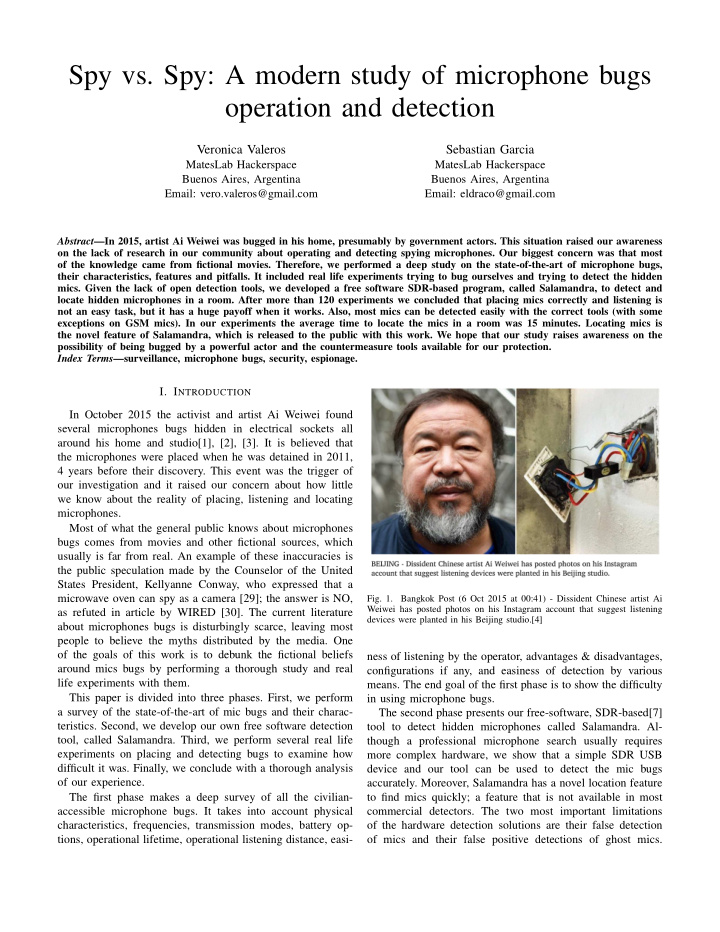



Spy vs. Spy: A modern study of microphone bugs operation and detection Veronica Valeros Sebastian Garcia MatesLab Hackerspace MatesLab Hackerspace Buenos Aires, Argentina Buenos Aires, Argentina Email: vero.valeros@gmail.com Email: eldraco@gmail.com Abstract —In 2015, artist Ai Weiwei was bugged in his home, presumably by government actors. This situation raised our awareness on the lack of research in our community about operating and detecting spying microphones. Our biggest concern was that most of the knowledge came from fictional movies. Therefore, we performed a deep study on the state-of-the-art of microphone bugs, their characteristics, features and pitfalls. It included real life experiments trying to bug ourselves and trying to detect the hidden mics. Given the lack of open detection tools, we developed a free software SDR-based program, called Salamandra, to detect and locate hidden microphones in a room. After more than 120 experiments we concluded that placing mics correctly and listening is not an easy task, but it has a huge payoff when it works. Also, most mics can be detected easily with the correct tools (with some exceptions on GSM mics). In our experiments the average time to locate the mics in a room was 15 minutes. Locating mics is the novel feature of Salamandra, which is released to the public with this work. We hope that our study raises awareness on the possibility of being bugged by a powerful actor and the countermeasure tools available for our protection. Index Terms —surveillance, microphone bugs, security, espionage. I. I NTRODUCTION In October 2015 the activist and artist Ai Weiwei found several microphones bugs hidden in electrical sockets all around his home and studio[1], [2], [3]. It is believed that the microphones were placed when he was detained in 2011, 4 years before their discovery. This event was the trigger of our investigation and it raised our concern about how little we know about the reality of placing, listening and locating microphones. Most of what the general public knows about microphones bugs comes from movies and other fictional sources, which usually is far from real. An example of these inaccuracies is the public speculation made by the Counselor of the United States President, Kellyanne Conway, who expressed that a microwave oven can spy as a camera [29]; the answer is NO, Fig. 1. Bangkok Post (6 Oct 2015 at 00:41) - Dissident Chinese artist Ai Weiwei has posted photos on his Instagram account that suggest listening as refuted in article by WIRED [30]. The current literature devices were planted in his Beijing studio.[4] about microphones bugs is disturbingly scarce, leaving most people to believe the myths distributed by the media. One of the goals of this work is to debunk the fictional beliefs ness of listening by the operator, advantages & disadvantages, around mics bugs by performing a thorough study and real configurations if any, and easiness of detection by various life experiments with them. means. The end goal of the first phase is to show the difficulty This paper is divided into three phases. First, we perform in using microphone bugs. a survey of the state-of-the-art of mic bugs and their charac- The second phase presents our free-software, SDR-based[7] teristics. Second, we develop our own free software detection tool to detect hidden microphones called Salamandra. Al- tool, called Salamandra. Third, we perform several real life though a professional microphone search usually requires experiments on placing and detecting bugs to examine how more complex hardware, we show that a simple SDR USB difficult it was. Finally, we conclude with a thorough analysis device and our tool can be used to detect the mic bugs of our experience. accurately. Moreover, Salamandra has a novel location feature The first phase makes a deep survey of all the civilian- to find mics quickly; a feature that is not available in most accessible microphone bugs. It takes into account physical commercial detectors. The two most important limitations characteristics, frequencies, transmission modes, battery op- of the hardware detection solutions are their false detection tions, operational lifetime, operational listening distance, easi- of mics and their false positive detections of ghost mics.
Recommend
More recommend